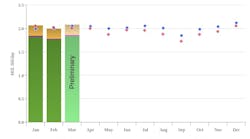Public scrutiny of the oil and gas industry is motivating companies to balance field development activities with environmental and community needs. It’s prudent for operators to communicate with stakeholders and discover their concerns as early as possible; projects can be slowed or even stopped by perceived shortcomings.
While the life of a field may be short, local communities remain firmly rooted and expect operators to preserve and often improve the quality of land, air, and water. Local stakeholders benefit from a stable tax base and work force, but workers in the field gravitate toward companies perceived as good neighbors.
Pinedale
In western Wyoming, the hydrocarbon-rich Green River basin is adjacent to Grand Teton and Yellowstone National Parks. The 200,000-acre Pinedale anticline hosts the second-largest natural gas field in the US, characterized by Shell as a “world-class” resource play.
The town of Pinedale sits at 7,175 ft elevation amid rolling hills of sagebrush, grass, and grazing cattle. Most of the surrounding land (80% of the Pinedale anticline producing area, or PAPA) is managed by the US Bureau of Land Management and leased for drilling. The other 20% is private fee land or controlled by the government of Wyoming.
Shell acquired McMurry’s Pinedale assets in November 2001 and then purchased acreage from EnCana Oil & Gas (USA) Inc., becoming the third-largest leaseholder after Ultra Petroleum Corp. and Questar (OGJ, Mar. 3, 2008, p. 37).
Shell’s US onshore asset manager, David Todd, said the company has drilled more than 180 tight gas wells at Pinedale since 2002 and expects to drill hundreds more in the next decade. The field’s 25 tcf of gas reserves could heat 10 million homes for 30 years.
Denver-based Deena McMullen manages Shell’s stakeholder relations in PAPA. She said the Pinedale anticline working group has eight separate groups focused on protecting air and water resources, wildlife, and the viewshed of the historic Lander Trail.
Ecology, regulations
Shell’s Aimee Davison, a biologist involved in permitting and environmental mitigation, showed OGJ the area’s high, cold desert, which supports a surprising diversity of plants and animals. Nine varieties of sage dominate the plains, interspersed with grasses and forbs. Cottonwood trees colonize streams; patches of aspen and conifers nestle against hills. Pronghorn antelope, deer, prairie dogs, gophers, and rabbits are common, along with eagles, hawks, owls, and a variety of other birds.
Davison said that a major environmental impact survey, conducted in 1997-2000, led to a record of decision finalized in July 2000. This includes seasonal wildlife stipulations that limit drilling to protect “crucial winter range” for mule deer, antelope, and moose and that specify buffer zones for raptors, sage grouse, mountain plovers, and other species.
Shell says the restrictions prevent operators from optimizing development and lead to increased traffic, extra rig moves, and surplus road-building, all of which contribute to environmental degradation. The fluctuating level of field work also takes an economic toll on local businesses and the workforce that supports drilling and production.
As Shell developed Pinedale, it found nearly 2.5 times the reserves it calculated in 2001. Todd said the rules issued in 2000 did not anticipate the reserves or necessary intensity of development.
Long term
In September 2005, Shell and other operators submitted a long-term management plan for BLM lands, proposing sequential development with year-round access in specific areas. The operators expect a ruling in September.
In the field, a maze of unpaved roads leads to drillsites supporting individual wells or small clusters. Pads disturb several acres of land and are visible for miles. Under the proposed development plan, directional drilling from multiwell pads and a new liquids-gathering system (produced water and condensate) would disturb only 8% of the surface and result in 70% fewer roads and 165 fewer pad sites than the total authorized by the 2000 record of decision.
Shell is restoring older drilling pads and has reclaimed 22 Pinedale locations in 4 years using a reformulated seed mix that includes forbs and sage to provide critical winter forage and cover for wildlife. Earlier attempts to reconstruct original habitat involved reseeding with fast-growing grasses that supplied only summer forage.
New emission technology is being installed on drilling rigs to reduce NOx emissions 80% from 2005 levels. Shell is also tracking volatile organic compound emissions and recently installed an air quality monitoring station to supply real-time data to scientists.
